How to make your dental practice more valuable at the time of sale
W. Paul Woody, MSA, CPA, CVA, EA
I started working with dentists in 1972.
In 1981, I started doing dental valuations. Through the years, I’ve discovered that many practices could have a higher value at the time of sale than what they actually have. This article will offer some suggestions and strategies on how to keep your practice updated so that you can take care of your current patients, and it will help you understand the dynamics that go into doing a dental valuation. Here is a summary of some of these strategies:
Keep your practice updated and fresh so that it doesn’t appear to be in decline. This may involve updating some of the older equipment and improving the way the office looks to patients when they come in the front door. Consider simple things, such as fresh flowers, new carpet, updated furniture, and a little paint.
Continue with a strong presence in terms of your gross and net collections. The business side of dentistry is so important, especially as you get closer to the time when you will sell your practice. The American Dental Association reports that the average dentist nationwide should net 35%, which means the off-setting 65% overhead could possibly be reduced and adjusted, depending on the needs of the practice. We like to emphasize to our dental clients to shoot for a net profit in the 40% to 45% range. We consider general dentists who can net 45% or better to have optimal practices.
Keep in mind that a true valuation engagement is done by reviewing five years of history. You will have to show five years of tax returns, so this is another reason to keep the practice going strong until you want to slow down. As many dentists get into their upper 50s and 60s, they start referring out procedures, which causes the practice to decline in terms of gross receipts. But they keep the same staff, which increases overhead. My recommendation is that when the time comes, consider doing the engagement then, and when you find a buyer, contract back and work on a part-time or as-needed basis.
Longevity is important. When someone is looking to buy a practice, they like to see that the dentist has had the same team for 10 years or longer. I recently did an engagement on a practice that had constant turnover. Many buyers interpret this as a stressful practice, and it probably won’t be valued as highly as a practice that has had the same team for 10-plus years. Yes, I know people change jobs and things change in their lives, but to the extent that you’re providing a great work environment, they should be in a position to stay a long time. Then the next buyer of the practice can walk right in and start doing quality dentistry on the first day that he or she owns the practice.
The dental CPA evaluating your practice must normalize the earnings of the practice. Many of our clients think that their practices will decline because they’re writing off fringe benefits through the practice. This is part of the normalization process, so the fact that you have a lot of continuing education or you go to exotic locations for some of those meetings will not adversely impact you, as long as you have the cash flow to make this happen. These adjustments are made to determine a fair and reasonable net profit for the practice, and when you divide that net profit by the five-year average gross receipts, hopefully you will end up with a net profit that is well above the 35% guideline set by the American Dental Association.
Many of our dental clients prefer to keep their buildings so that they can continue to generate rental income for at least five years. Most of these situations come with a lease option to buy the building in five years. Often the buying dentist wants to rent the building for five years so that he or she can pay down the debt from buying the practice. Then the person will consider making the building purchase possibly in the fifth or sixth year. However, depending on the condition of the building and whether it’s updated, the buyer may not want to buy the building. Therefore, there is some risk associated with the transition. As a result, many dentists may want to rethink the real estate part. If you do own the real estate, you may want to sell the building at the same time you sell the dental practice. The rules for keeping the building updated are the same as those for updating the dental practice. You want to make sure that the building is not run down. Creating a checklist of things to keep that building in good shape is a good idea.
If you’re selling your practice, be reasonable on the price. There is a big need for private practice dentistry. My son and I, along with many of the members of the Academy of Dental CPAs, work diligently to talk at the various dental schools around the country about the importance of entrepreneurship and owning and operating your own practice. However, you need to be reasonable on what you accept as an offer for your practice. Remember, the buyer will always think the value is overstated, and the seller will always think that the value is understated.
W. Paul Woody, MSA, CPA, CVA, EA, launched his career in accounting and tax in 1972. He started working with dentists the same year and now works with over 300 of them. He is enrolled to practice before the Internal Revenue Service. His son, Grant, joined his firm in 1994 and became a partner in 2006. Together they present a seminar every September for the University of Oklahoma College of Dentistry on entrepreneurship. Paul is a member of the Academy of Dental CPAs, which meets twice a year to discuss strategies to help dentists become more profitable.


